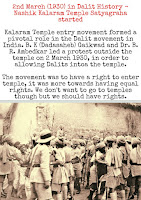VSK TN

2. Temple Entry
In order to get an entry into the temples for untouchables, Babasaheb Ambedkar led the satyagrah for entry to the Kalaram Temple of Nashik, Maharashtra. This was on 2nd March, 1930.
3. Conversion to Buddhism
Speaking about the necessity of conversion, Dr. Ambedkar had, in a speech in 1935, said, “After giving deep thought to the problem, everybody will have to admit that conversion is necessary to the Untouchables as self-government is to India. The ultimate object of both is the same. There is not the slightest difference in their ultimate goal. This ultimate aim is to attain freedom. And if the freedom is necessary for the life of mankind, conversion of Untouchables which brings them complete freedom cannot be called worthless by any stretch of imagination.”
On October 14, 1956, the leader adopted Buddhism, along with lakhs of his followers in a simple, traditional ceremony at Deekshabhoomi, Nagpur.
4. The Father of Indian Constitution
Dr. Ambedkar was the chairman of the Drafting committee of the Indian constitution.
Making of Indian Constitution was completed in the year 1949, on the 26th of November, by the Constituent Assembly. It took 2 years 11 months and 17 days to draft and finalize the Constitution of India. The very first meeting of the Indian Constituent Assembly took place in the year 1946, on the 9th of December. The assembly was reformed as the sovereign Constituent Assembly for the Dominion of India on the 14th August, 1947.The Making of Indian Constitution took several meetings of the three committees, namely, The Union Powers Committee, the Union Constitution Committee and the Committee on Fundamental Rights.
After observing the reports passed by these three committees, the Assembly went on to create a Drafting Committee, in the year 1947, on the 29th of August. The chairman of this Drafting Committee, as per the history of Indian Constitution, was Dr. B.R. Ambedkar. After becoming the chairman, Dr. Ambedkar passed proposals for a Draft Constitution of India. This Draft Constitution of India was finally passed after several meetings held during the months of October and November 1949.
On the 26th of November, in the year 1949, the Making of Indian Constitution was complete and was successfully passed after the signature of the President of the Assembly. The sections that came into immediate effect from the on the 26th of November 1949, were those related to the elections, citizenship, the provisional Parliament as well as the temporary and the transitional provisions. The sections that were left in the Indian Constitution were implemented on the 26th of January, in 1950.
